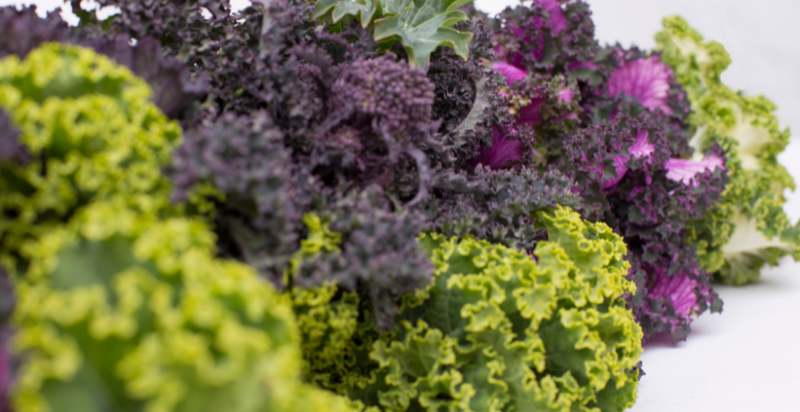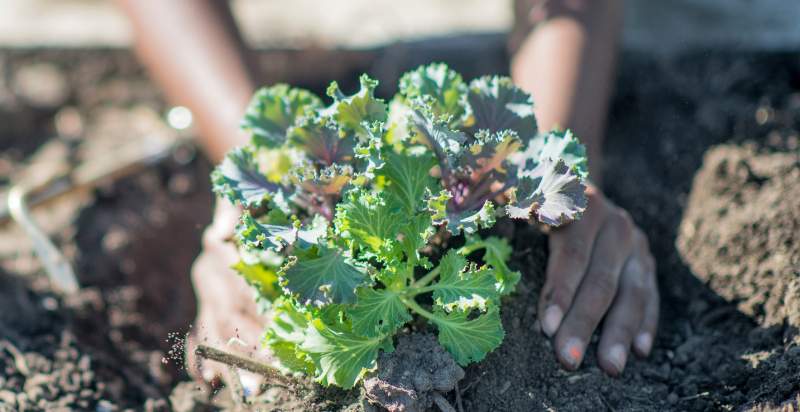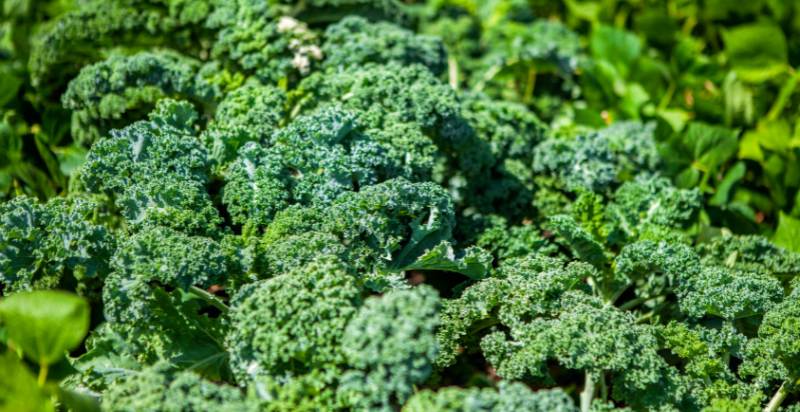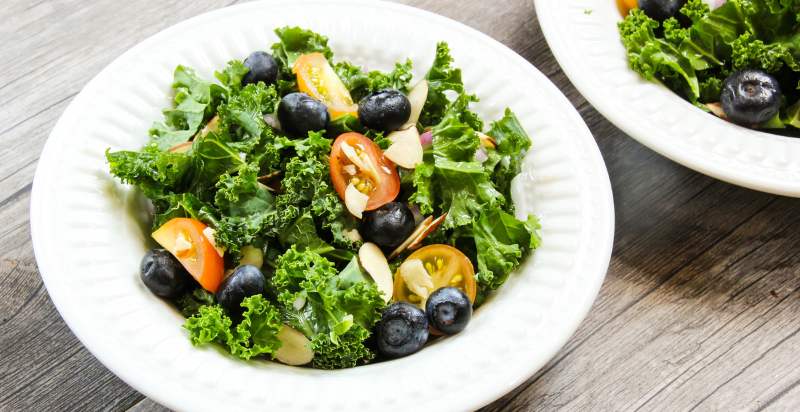Kale is a leafy green vegetable part of the Brassica family, including cruciferous vegetables such as cabbage, Brussels sprouts, and broccoli. It has been consumed for centuries and was a popular plant in Ancient Greece and Rome. Kale is highly nutritious and contains many essential vitamins and minerals.
In addition to being low in calories and a good source of fiber, it also provides significant amounts of vitamins A, C, K, B6, and folate. Kale is often eaten raw or cooked in recipes such as salads, soups, or stews.
History and Origin of Kale:
Kale has been around for centuries and is believed to have originated in the Mediterranean region. It was cultivated by Ancient Greeks and Romans and was a popular vegetable. Kale spread throughout Europe and eventually made its way to North America, becoming a popular crop for colonial farmers. Today, kale is consumed worldwide and regarded as one of the healthiest vegetables.
Types of Kale:
Several types of kale are available, including curly kale, Siberian kale, and ornamental kale. Curly kale is the most common type of kale and is a dark green color with a slightly sweet flavor. Siberian Kale has frilled edges and a milder taste than curly kale. Ornamental Kale, also known as salad savoy, has colorful leaves in shades of red, purple, and white.

Nutritional Benefits of Kale:
Kale has a wide range of health benefits due to its high nutrient content. One cup (67 grams) of raw kale contains 33 calories, 6 grams of carbohydrates, 2.9 grams of protein, and 0.7 grams of fat. It is also an excellent source of dietary fiber, with 3.6 grams per cup (67 grams).
Kale is an excellent source of vitamins A and C. One cup (67 grams) provides 206% and 134% of the recommended daily value for these vitamins. Vitamin A plays a role in vision health and immunity, while vitamin C helps form collagen and protect against oxidative damage from free radicals.
Kale is also a good source of B vitamins such as thiamin, riboflavin, niacin, and folate. These vitamins are important for energy production and help to regulate metabolism.
Kale is also high in minerals such as calcium, magnesium, potassium, and iron. Calcium helps build bones and teeth, while magnesium helps with nerve and muscle function. Potassium can help lower blood pressure and reduce the risk of stroke, while iron plays a role in red blood cell production and oxygen transport throughout the body.
Uses of Kale:
Kale can be eaten raw or cooked in a variety of dishes. It can be added to salads, soups, or stews for extra nutrition or used as a side dish. Kale chips are also popular snacks that are easy to make at home. Kale can also be blended into smoothies for an added nutritional boost.
How to Plant Kale?
Kale plant is an incredibly nutritious and delicious leafy green vegetable. It’s packed with vitamins, minerals, and fiber, making it a great choice for any healthy diet. Planting Kale is easy and rewarding – with the right preparation, you can have fresh leaves in your garden in no time!
What You’ll Need:
Before you get started planting Kale in your garden, there are a few materials that you’ll need to ensure success. These include:
- Seeds: Make sure you buy quality kale seed from a reputable source, as this will make all the difference in germination rates and the plants’ eventual yield.
- Soil: Kale prefers well-draining, slightly acidic soil, so make sure you purchase soil that meets these requirements.
- Fertilizer: Kale will benefit from regular fertilizing, especially during the early stages of growth. A balanced fertilizer like 10-10-10 is perfect for this.
- Mulch: Applying mulch to your Kale plants helps keep moisture in the soil and wards off weeds and pests.
Preparing the Garden Bed:
Once you have all your materials together, it’s time to prepare the garden bed for planting. Begin by tilling the soil to remove any lumps or clumps. This will help ensure the even and successful germination of your seeds. Once tilled, add a layer of fertilizer and mix it into the soil thoroughly. After this, rake the soil, so it is level and free of debris.
Planting Kale:
Once your garden bed is prepared, you can begin planting your kale seeds. Plant each seed approximately 1/2 inch deep in the soil and cover them with a light layer of mulch to help retain moisture. Water your newly planted seeds daily and keep an eye out for germination – which should occur within 10-14 days; when the plants reach about two inches tall, thin them out to leave only the strongest seedlings for further growth.

Caring for Your Kale Plants:
Now that you have planted your Kale, there are a few things you can do to ensure it grows strong and healthy. Be sure to water your plants regularly – about 2-3 times a week should be sufficient if the weather is mild. Fertilize your plants with a balanced fertilizer every couple of weeks to give them the nutrients they need for optimal growth. Also, keep an eye out for pests and weeds and take action as soon as you see any signs of damage or infestation.
Harvesting Kale:
When harvested correctly, Kale can provide you with fresh leaves for months! To harvest Kale, snip off the outer leaves using scissors or kitchen shears when they reach 4-6 inches in length. Ensure to take only a few from each plant, as this will reduce their yield.
Planting Kale is a rewarding and easy experience – with just a bit of preparation and knowledge of how to care for your plants, you can have fresh greens in your garden for months! So get out there, grab some seeds, and start planting! Enjoy the harvest!
How to Care For Kale Plant?
Kale Plant is a hardy and reliable vegetable that requires very little maintenance. However, there are some steps you can take to ensure optimal growth and productivity of your plants.
- Watering: Kale needs regular watering throughout the growing season to thrive. Make sure to water your plants about 2-3 times a week during the spring and summer months. It’s important not to overwater, as this can lead to root rot or other issues.
- Fertilizer: Kale plant will appreciate an occasional boost with fertilizer – especially if it grows in nutrient-poor soil. A balanced fertilizer such as 10-10-10 should be applied every few weeks during the growing season for maximum results.
- Weed Control: Kale plant can be susceptible to weeds, so it’s important to take action as soon as you see them popping up. Pulling weeds by hand is the best control method, but you can also use a pre-emergent weed killer if necessary.
- Harvesting: When harvesting your Kale leaves, make sure to take only a few from each plant – this will reduce yield and could cause the plant to become stressed out. Snip off the outermost leaves when they reach 4-6 inches in length for optimal results.
Following these simple steps, your kale plants should thrive and provide fresh greens all summer.

Additional Things to Know About Kale:
Kale is a nutrient-packed vegetable that can provide your diet with lots of vitamins and minerals. It’s also low in calories and fiber, making it a great addition to any healthy diet. Kale is also very versatile – it can be cooked or eaten raw, added to smoothies, salads, and soups, or used as a garnish on dishes. No matter how you eat it, there are plenty of ways to enjoy this delicious green!
Kale is also easy to grow at home and makes an excellent addition to any garden. With just a bit of soil preparation and general care, you can have fresh greens from your backyard all season long – perfect for enjoying the harvest with friends and family! So get out there and try it – you won’t regret it!
Preventions From Pests and Diseases:
When it comes to pests and diseases, prevention is key. Make sure your plants grow in well-drained soil with plenty of organic matter, such as compost or manure. Also, be sure to rotate crops so that the same type of plant isn’t grown in the same spot year after year – this will prevent specific pests and diseases from taking hold.
Finally, keep an eye out for signs of infestation or disease and take action quickly if you notice anything out of the ordinary. This can include removing affected leaves, treating the plants with an appropriate pesticide or fungicide, and providing additional care, such as mulching, to protect your plants from further damage.
Finally, it’s important to inspect your Kale plants regularly for signs of disease, pest damage, or infestation. Please pay close attention to the stems and leaves of each plant and remove any evidence of pests or disease before it spreads throughout the garden.
Treat affected areas with a pesticide or fungicide to prevent further spread. Keep an eye out for anything unusual that could indicate an underlying problem. By following these few steps, you can ensure your kale plants will remain healthy and productive for many years.
How to Harvest Kale Plants?
Harvesting your Kale plant is easy and can be done anytime during the growing season. The best time to harvest is when the leaves are 4-6 inches long, as this will ensure you get the most out of each plant. When harvesting kale, it’s important to take only a few leaves from a single plant – doing so will reduce yield and could stress the plant out.
To harvest your Kale plants, snip off the outermost leaves with scissors or pruning shears. Aim for individual leaves rather than entire stems, and make sure not to pluck too many at once – this way, you can enjoy fresh greens all summer long! Once harvested, store your kale in the refrigerator to keep it fresh.

How to Store Homegrown Kale?
Once you’ve harvested your Kale plants, the next step is to store them properly, so they remain fresh for as long as possible. The best way to store homegrown kale is in a plastic bag or container in the refrigerator. This will help keep it fresh and crisp for up to two weeks – be sure to check it periodically for signs of spoilage or wilting. If your kale gets limp or yellow, it may be time to throw it out and start again with fresh leaves.
You can also freeze your kale if you’d like – blanch the leaves first (by boiling them for 1-2 minutes), then rinse them with cold water before storing them in an airtight container or bag in the freezer. Frozen kale should last up to 6 months to enjoy homegrown greens all year round!
Kale is an incredibly versatile and nutritious veggie that is easy to grow and store at home. With just a bit of preparation and general care, you can enjoy delicious greens from your garden all season long – perfect for sharing with friends and family. So get out there and try it – you won’t regret it!
How to Use Kale?
Kale is an incredibly versatile vegetable that can be used in various dishes. The leaves are delicious when sautéed with garlic, olive oil, and other vegetables or added to soups and salads for extra flavor. Kale chips make a great snack that’s both tasty and healthy – they’re also easy to make at home! Kale juice is another popular option – blend it with your favorite fruits and veggies for an amazing energy boost. You can also use kale in smoothies, sandwiches, omelets, or even baking treats like muffins and cakes. With so many ways to enjoy this nutrient-packed veggie, you’ll never get bored eating kale!

Potential Risks from Kale:
Though kale is an incredibly healthy vegetable, some potential risks are associated with it. Raw or undercooked kale may contain harmful bacteria or parasites that can cause food poisoning, so always make sure to properly clean and cook your greens before consuming. Additionally, kale contains oxalates which can interfere with the absorption of certain minerals such as calcium and iron in the body – over consuming these oxalates can lead to kidney stones and other side effects.
If you have a history of kidney stones or other health issues, please speak to your doctor before incorporating kale into your diet. Though these potential risks should be considered, they should not stop you from enjoying this nutritious veggie in moderation!
Conclusion:
Overall, Kale is a great vegetable to include in your diet. It’s relatively easy to grow, store and use – plus it’s packed with amazing health benefits. With just a bit of care, you can enjoy all the deliciousness that homegrown Kale offers! So why give it a try today?
With the right soil preparation, weed control, and general care, your Kale plants will thrive in no time. Whether you’re looking to enjoy the harvest with friends and family or use it as a nutritious addition to any meal, Kale is an excellent choice for any garden. Just remember to give your plants enough space, inspect them regularly for signs of pests or disease – and remember to have fun at it! Happy gardening!
- Everything You Wanted to Know About Red Tamarillos - June 2, 2025
- A Guide to Tulips: Everything You Need to Know & More… - June 2, 2025
- Guanabana: Description, Flavor, Benefits, And Uses - May 27, 2025

20 thoughts on “What is Kale? How to Plant, Grow, and Harvest Kale Plants. ”
Comments are closed.